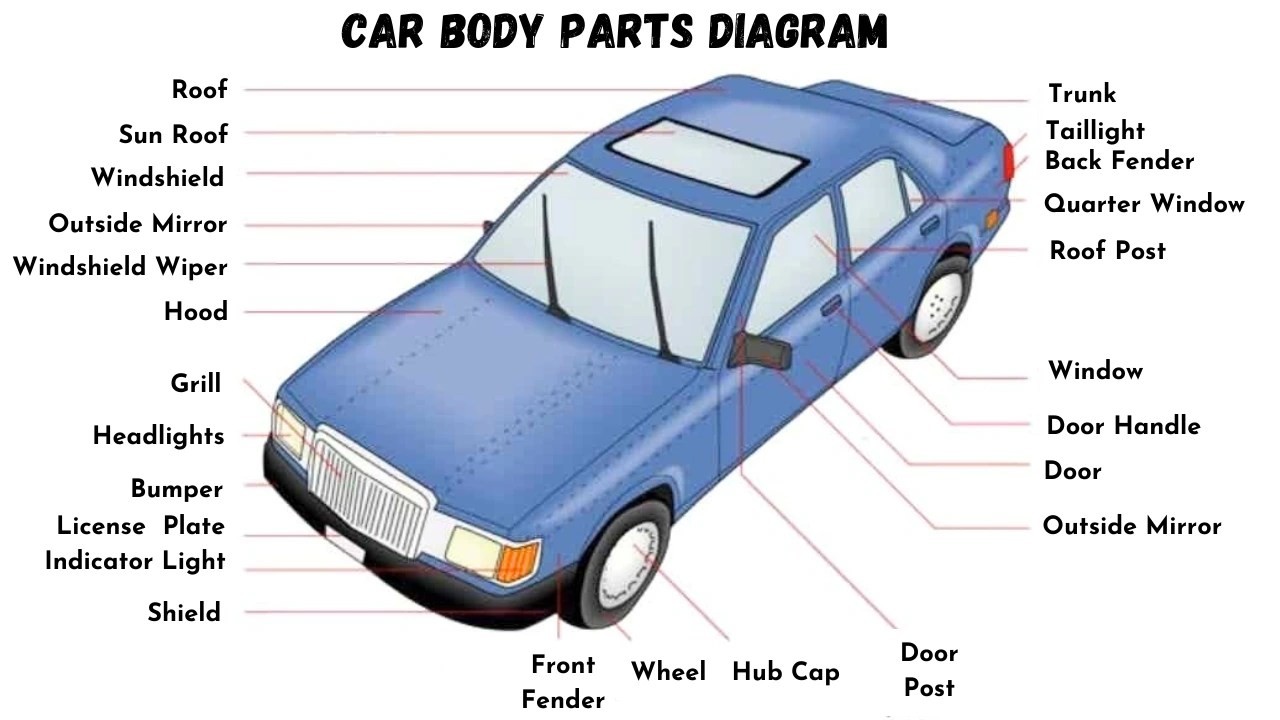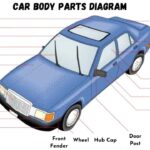Have you ever stood in front of a vehicle, gazing at its intricate structure, and wondered about the names of each component? Just like the human body, a car is composed of numerous parts working in harmony. Understanding these parts, especially the front car parts, is essential for car enthusiasts, DIY mechanics, and anyone looking to deepen their automotive knowledge.
This article will serve as your detailed guide to Front Car Parts Names, exploring their functions and significance. We will delve into each component, providing you with a comprehensive understanding that surpasses the basic overview of car anatomy.
Exploring the Front Anatomy of a Car
The front of a car is a complex assembly of parts designed for safety, aerodynamics, and aesthetics. Let’s break down the key components you’ll find at the front of most vehicles:
1. Hood or Bonnet
The hood, also known as the bonnet in some regions, is the hinged metal cover that shields the engine compartment. It’s a crucial safety feature, protecting the engine and vital components from the elements and physical damage. The hood also provides easy access for maintenance and repairs. Typically constructed from steel or aluminum, some aftermarket hoods utilize lighter materials like carbon fiber or fiberglass for performance enhancements. A latch, often concealed, keeps the hood securely closed, while a release lever inside the car allows for opening it.
2. Front Bumper
The front bumper is a horizontal bar located at the very front of the vehicle. Its primary role is to absorb impact during low-speed collisions, protecting the car’s body, headlights, and grille from damage. Modern bumpers are often made of plastic or composite materials, designed to deform and cushion impacts. They integrate with the vehicle’s design, often wrapping around the front corners and sometimes housing fog lights or sensors.
3. Bumper Grille (or Front Grille)
Located between the headlights, the bumper grille, or simply front grille, is a patterned mesh or series of bars that allows air to flow into the engine compartment. This airflow is vital for cooling the engine and radiator. Grilles are designed to be both functional and aesthetically pleasing, often becoming a signature design element for different car brands. Variations include main grilles, lower grilles, and specialized designs like BMW’s kidney grilles.
4. Headlights
Headlights are essential lighting components mounted at the front of the vehicle, designed to illuminate the road ahead during nighttime or low-visibility conditions. Modern headlights are complex systems incorporating various technologies like halogen, LED, or xenon bulbs, and often include daytime running lights (DRLs) and automatic leveling systems. They are crucial for safe driving, ensuring the driver can see the road and be seen by other drivers.
5. Fog Lamps
Fog lamps are auxiliary lights positioned lower than the headlights, often integrated into the bumper. They are designed to improve visibility in dense fog, mist, rain, or dust. Their low positioning helps them cut under the fog layer, illuminating the road surface more effectively than headlights in adverse weather.
6. Indicator Lights (Turn Signals)
Indicator lights, also known as turn signals or blinkers, are located at the front (and rear) corners of the car. They are flashing lights that signal the driver’s intention to turn left or right. These are vital for communication with other drivers and pedestrians, ensuring safe lane changes and turns. Modern cars often feature integrated indicator lights in the side mirrors as well for increased visibility.
7. Fenders
Fenders, sometimes referred to as wings (especially in British English), are the curved body panels that frame the wheel arches. Their primary function is to prevent debris like mud, rocks, and water from being thrown up by the tires and hitting the car body or other vehicles. Front fenders are located above the front wheels and contribute to the car’s overall aerodynamics and styling.
8. Fender Liners (or Wheel Well Liners)
Fender liners, also known as wheel well liners, are plastic or composite inner panels fitted inside the fenders. They provide additional protection to the fenders and the engine compartment from water, salt, and debris thrown up by the tires. Liners also help reduce road noise and prevent corrosion within the wheel well area.
9. Radiator
The radiator is a crucial component of the engine cooling system, typically positioned behind the front grille. It’s a heat exchanger that dissipates heat from the engine coolant, preventing the engine from overheating. Airflow through the grille is essential for the radiator’s function.
10. Radiator Supports
Radiator supports are structural elements, usually metal, that hold the radiator in place and provide mounting points for other front-end components like the grille and headlights. They form part of the car’s frontal structure and contribute to crash safety.
11. Cowl Panel
The cowl panel is the area at the base of the windshield, often housing the windshield wipers and air intakes for the cabin ventilation system. It’s a panel that bridges the gap between the hood and the windshield, contributing to the car’s aerodynamics and water management.
12. Windshield Wipers
Windshield wipers are mechanical arms with rubber blades that sweep across the windshield to remove rain, snow, and debris, ensuring clear visibility for the driver. They are operated by a wiper motor and system located beneath the cowl panel.
13. Front Windshield (or Windscreen)
The front windshield, or windscreen, is the large glass panel at the front of the car that provides visibility and protection for the occupants. It’s made of laminated safety glass designed to withstand impacts and shatter safely.
14. Front Quarter Panel
The front quarter panel is the body panel located between the front door and the fender. It’s a significant part of the car’s side structure and styling, often incorporating side marker lights or styling lines. In some cases, the fender itself might be referred to as a quarter panel, especially the front portion.
15. Mirrors (Side Mirrors or Wing Mirrors)
While technically on the sides, side mirrors, also called wing mirrors, are crucial for front visibility. They provide the driver with a view of the sides and rear of the vehicle, essential for safe lane changes, parking, and maneuvering. Modern cars often have electronically adjustable and heated side mirrors.
Understanding the Importance of Front Car Parts
Knowing the names and functions of front car parts is more than just automotive trivia. It’s practical knowledge that can be useful in various situations:
- Communication with Mechanics: When describing a car issue to a mechanic, knowing the correct part name ensures clear and efficient communication.
- DIY Car Maintenance: For those who enjoy DIY car maintenance, understanding front car parts is essential for repairs and upgrades.
- Accident Situations: In case of an accident, accurately identifying damaged front parts is crucial for insurance claims and repair estimates.
- Car Enthusiast Knowledge: For car enthusiasts, knowing the anatomy of a car enhances appreciation and understanding of automotive engineering and design.
Conclusion: Expanding Your Automotive Vocabulary
Understanding “front car parts names” is a valuable step in expanding your automotive knowledge. This guide has provided a detailed overview of the key components at the front of a car, from the protective bumper to the essential headlights and ventilation grille. By familiarizing yourself with these terms, you’ll be better equipped to understand your vehicle, communicate with automotive professionals, and deepen your passion for cars. Continue exploring the fascinating world of automotive engineering and discover the names and functions of car parts all around your vehicle!

